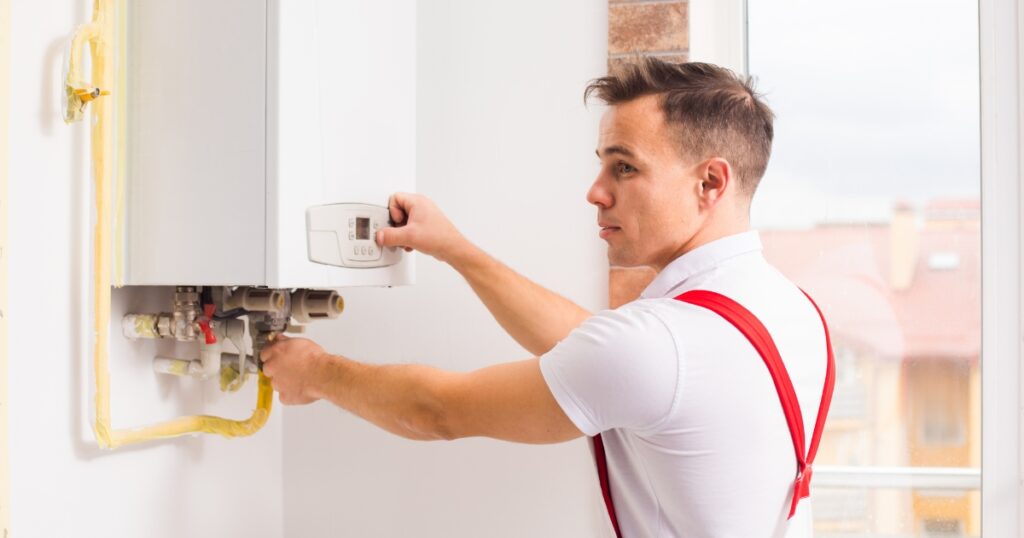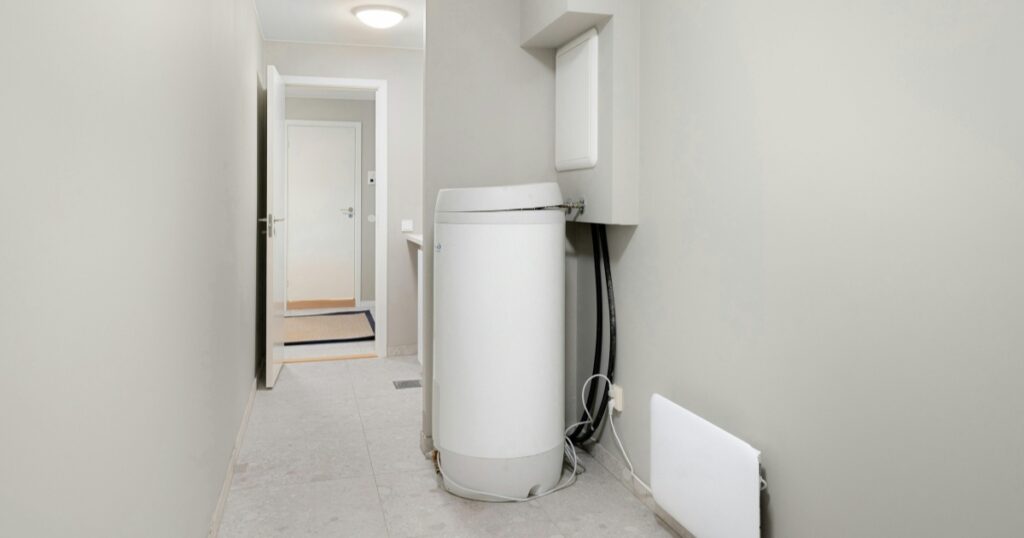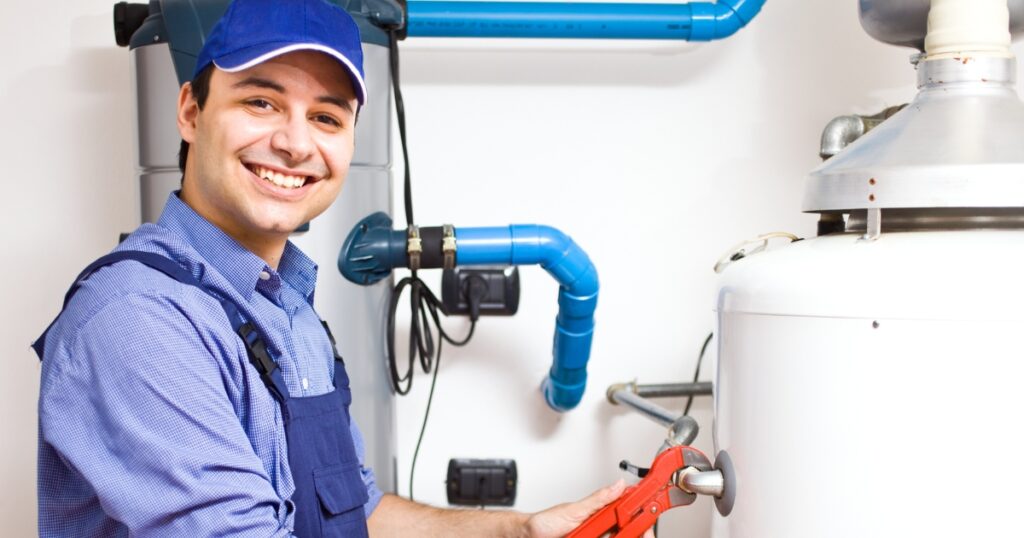Nothing’s worse than waking up on a chilly morning, only to be greeted by a dribble of hot water in the shower. It’s enough to start your day on the wrong foot! Many Aussie homes face this issue due to sediment build-up, throwing a spanner in our morning routines.
This piece will walk you through sorting out niggling hot water pressure problems, without needing to decode plumber-speak. Time to get those mornings back on track!
Key Takeaways
- Sediment buildup, blocked or leaking pipes, and faulty pressure regulators are common causes of low hot water pressure in Aussie homes. Regular maintenance can prevent these issues.
- High hot water pressure might be due to obstructed flow, malfunctioning valves, or too high city water pressure. It’s important to address these problems quickly to avoid plumbing damage.
- Checking and cleaning showerheads and taps can improve hot water pressure. Sometimes replacing faulty pipes or installing a pressure boosting system is necessary for better flow.
- Hiring a professional plumber ensures thorough inspection and repair of your plumbing system. This helps in diagnosing the exact cause of hot water pressure problems and fixing them efficiently.
- Regularly maintaining your home’s plumbing system by flushing the water heater tank and checking for leaks can keep your hot water running smoothly without unexpected drops in pressure.

Understanding Water Pressure
Understanding water pressure involves grasping the concept of how force impacts the flow of water and recognising different types of pressure issues that may arise. This understanding allows us to troubleshoot and seek solutions for common hot water pressure problems effectively.
What is water pressure?
Water pressure is simply the force that moves water through our pipes and into our homes. It’s what ensures that when we turn on a tap, water comes out with enough strength to wash dishes, take showers, or fill up a kettle quickly.
We often don’t give much thought to how crucial good water pressure is until we encounter problems like dribbling taps or an unsatisfying shower.
Dealing with hot water system problems starts by understanding the basics of water pressure.
Our daily comfort and convenience rely heavily on maintaining optimal hot water pressure. From quicker dishwashing sessions to more enjoyable showers, the right pressure makes all the difference in our household routines.
Whether tackling low hot water pressure in all faucets or finding solutions for sudden decreases in hot water pressure, knowing how this fundamental feature works sets us up for smoother problem-solving down the line.
How does it work?
To understand how hot water pressure works, it’s crucial to grasp the concept of water pressure itself. Water pressure refers to the force exerted by the water against the walls of its container.
In your plumbing system, this force is what pushes the water through your pipes and out of your taps or showerheads at a consistent rate. This means that when there are issues affecting your hot water pressure, it often involves something hindering this natural flow, such as blockages in pipes or faulty valves.
When addressing low hot water pressure problems, it’s essential to consider factors such as blocked or leaking pipes, which can restrict the flow of heated water into your fixtures.
Different types of water pressure issues
Hot water pressure issues can manifest in different ways, and it’s important to recognise the various types.
- Low Water Pressure: This issue can result from blocked or leaking pipes, a faulty pressure regulator, or sediment buildup, affecting your ability to have a satisfactory shower experience.
- High Water Pressure: Obstructed flow, a faulty pressure-reducing valve, or excessive city water pressure can lead to higher than normal hot water pressure, potentially causing damage to your plumbing system.
- Uneven Pressure: Sometimes, you may notice low hot water pressure but normal cold water pressure. This could be due to a number of factors such as the state of the hot and cold-water pipes within your house.
Understanding these pressing issues is vital for maintaining a comfortable living environment at home.
Common Causes of Low Water Pressure
Low water pressure can be caused by various factors such as blocked pipes, leaking pipes, faulty pressure regulators, and sediment buildup. Identifying these issues is crucial for effectively addressing low hot water pressure problems.
Blocked pipes
When pipes become blocked, it can lead to a decrease in water pressure. Sediment buildup, mineral deposits, or even foreign objects can cause blockages and restrict the flow of hot water through the plumbing system.
A professional plumber can identify and address these blockages by using specialised tools to clear the pipes and restore proper water pressure.
Regular maintenance of your plumbing system including cleaning out drains, flushing the hot water tank periodically, and being mindful of what goes down the drain can help prevent blockages from occurring.
Leaking pipes
Leaking pipes can lead to a significant decrease in hot water pressure, causing inconvenience and discomfort. Identifying and repairing these leaks promptly is crucial to maintaining optimal water pressure in your home.
Look out for damp spots or mould growth near pipes, visible corrosion, or unexplained water puddles around your property as these could indicate leaking pipes. Engaging a professional plumber to fix the issue will ensure that the repairs are carried out effectively and efficiently.
When dealing with leaking pipes, it’s essential to act swiftly to prevent further damage and maintain adequate hot water pressure throughout your household. Regular maintenance of your plumbing system, including checking for leaks, will also help avoid sudden decreases in hot water pressure caused by leaky pipes.
Faulty pressure regulator
A faulty pressure regulator can lead to low water pressure in your hot water system. When the regulator malfunctions, it fails to maintain the correct pressure, impacting the flow of hot water through your taps and showerheads.
To address this issue, homeowners should have a professional plumber inspect the regulator and replace it if necessary.
Aside from obstructing water flow, a faulty pressure regulator can disrupt the overall performance of your hot water system. Replacing or repairing this component will help ensure consistent and adequate hot water pressure throughout your home, allowing you to enjoy reliable access to heated water.
Sediment buildup
If the hot water pressure in your home seems to be decreasing, one of the common causes could be sediment buildup. Sediment can accumulate in your water heater over time from minerals and other particles present in the water.
This buildup can create blockages that restrict the flow of hot water, leading to lower pressure when you turn on your taps or showerheads.
Addressing sediment buildup may involve flushing out the water heater tank to remove any accumulated debris and sediments. Regular maintenance and cleaning of the water heater can help prevent further sediment buildup, ensuring consistent hot water pressure throughout your home.
Common Causes of High Water Pressure
High water pressure can lead to a range of plumbing issues, impacting the longevity of your system and potentially causing leaks or bursts. It is crucial to identify the underlying causes and address them promptly to prevent any further damage.
Obstructed flow
When there’s an obstructed flow in your hot water system, it can lead to decreased water pressure. Sediment buildup or debris in the pipes is often the culprit for this issue. The blockage restricts the smooth flow of water and reduces the overall pressure in your hot water system.

It’s essential to address this promptly to restore optimal water pressure and avoid potential damage to your plumbing system.
Regularly inspecting and cleaning your pipes can help prevent obstructed flow issues, ensuring that you maintain consistent hot water pressure throughout your home.
Faulty pressure-reducing valve
We’ve covered the issue of obstructed flow, and now let’s tackle another common culprit for high water pressure problems: the faulty pressure-reducing valve. This essential component regulates the incoming water pressure from the main supply to a safe level for your plumbing system.
When this valve malfunctions, it can lead to excessively high water pressure throughout your home. This can cause stress on your pipes and fixtures, potentially leading to leaks or bursts.
If you’re experiencing unexpectedly high water pressure, having a plumber check and potentially replace the faulty pressure-reducing valve is crucial in maintaining a healthy plumbing system.
City water pressure
When it comes to city water pressure, it can have a significant impact on the hot water pressure in your home. High city water pressure can cause stress on your plumbing system and lead to leaks or bursts in pipes.
Conversely, low city water pressure can result in inadequate flow and reduced hot water pressure throughout your home. Understanding the level of city water pressure helps homeowners identify potential issues with their hot water systems.
Moving forward, let’s address common causes of low hot water pressure and how they affect your daily usage.
How to Address Low Water Pressure Issues
To address low water pressure issues, consider hiring a professional plumber for thorough inspection and repairs. Check and clean showerheads and taps, replace faulty pipes or valves or install a pressure-boosting system for improved water flow.
Hiring a professional plumber
When addressing hot water pressure issues, it is crucial to hire a professional plumber who possesses expertise in resolving plumbing problems. Professional plumbers have the necessary skills and experience to accurately diagnose the cause of low or high water pressure and implement effective solutions.
They can conduct a thorough inspection of your plumbing system, identify any underlying issues such as blocked or leaking pipes and recommend appropriate repairs or replacements to restore optimal water pressure within your home.
Engaging a professional plumber ensures that the hot water pressure problems are addressed comprehensively, providing you with peace of mind and saving you from potentially costly repairs in the future.
By entrusting this task to qualified professionals, you can be confident that they will use their knowledge and tools to rectify the issue efficiently, allowing you to enjoy consistent hot water flow throughout your property without any disruptions.
Checking and cleaning showerheads and taps
When it comes to increasing hot water pressure, checking and cleaning showerheads and taps is crucial. Sediment buildup in these fixtures can significantly reduce water flow. To improve the pressure, unscrew the showerhead and tap the aerator, then soak them in vinegar to dissolve any mineral deposits.
Once cleaned, reattach them securely for better water flow.
Addressing low water pressure often involves tackling multiple issues simultaneously. By focusing on each aspect of your plumbing system, you can effectively troubleshoot and resolve hot water pressure problems.
Replacing faulty pipes or valves
After checking and cleaning showerheads and taps, it may be necessary to replace faulty pipes or valves if the water pressure issues persist. Hiring a professional plumber will ensure that any damaged or worn-out pipes are replaced with new ones, while also addressing any valve-related problems.
By replacing these components, we can significantly improve hot water pressure and prevent further issues from arising.
In addition to fixing low hot water pressure, it is crucial to keep an eye out for any signs of damage or deterioration in the plumbing system. Regular maintenance and quick action, when issues arise, will help maintain proper water flow throughout the home.
Installing a pressure-boosting system
When increasing the hot water pressure from the water heater, installing a pressure-boosting system can be an effective solution. This process involves adding a pump to boost the water pressure in your plumbing system.
By doing this, we can ensure consistent and improved hot water flow throughout your home. Additionally, it helps rectify low hot water pressure problems caused by factors such as gravity-fed systems or insufficient municipal supply.
By making use of professional services for understanding typical hot water pressure issues in Australia and carrying out installations like adding a pressure boosting system, you could potentially enjoy several benefits: enhanced shower experiences, quicker bath filling times, better dishwashing effectiveness, and an overall improvement in the performance of your home’s plumbing infrastructure.
Understand the Common Hot Water Pressure Problems
Understanding common hot water pressure problems is crucial for homeowners. Low water pressure issues can be caused by blocked or leaking pipes, while high water pressure can result from obstructed flow or faulty valves.
Addressing low water pressure may involve hiring a professional plumber, cleaning showerheads and taps, or installing a pressure-boosting system. Contact us and resolve hot water pressure problems and ensure a steady flow of hot water in your home.






